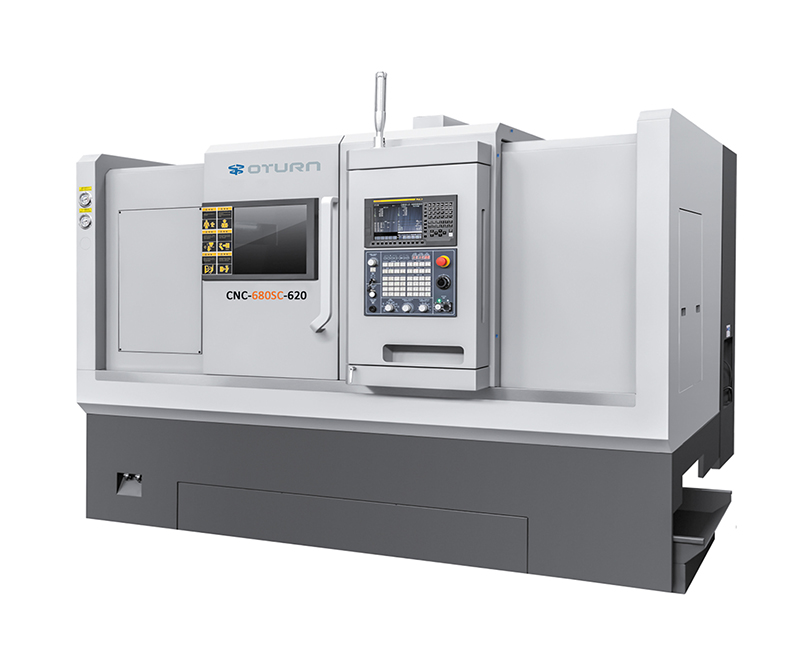Frequency of clamping, workpiece positioning errors, and machining cycles are key bottlenecks restricting productivity in traditional processes. Dual-spindle CNC turning center, with two independent spindles, achieve parallel/composite machining, significantly improving capacity, reducing errors, and shortening cycles, becoming a crucial pillar for the intelligent upgrading of the manufacturing industry.
Contents:
1. Applications of Dual-Spindle Turning Center in Various Fields
· Automotive Manufacturing: Dual Improvement in Efficiency and Quality
· Aerospace: Breakthrough in High-Precision Complex Structures
· Precision Molds: One-Step Molding and Surface Quality Optimization
· Emerging Fields: Extension of Flexibility and Intelligence
2.Key Considerations for Purchasing and Selection
In the process of manufacturing transformation towards intelligence and precision, Dual-spindle CNC lathe, with their unique collaborative design, have become key equipment for improving production efficiency, machining accuracy, and process flexibility. Through parallel and composite machining of two independent spindles, these machine tools can complete multiple processes and handle highly complex parts in a single clamping, and are widely used in the high-end manufacturing needs of the automotive, aerospace, precision mold, and emerging fields.
Automotive Manufacturing: Dual Improvement in Efficiency and Quality
Typical components such as engine blocks, crankshafts, and transmission housings require simultaneous high-precision roughing and finishing. The parallel machining capabilities of dual-spindle machine tools significantly shorten machining cycles, reduce positioning errors caused by multiple clamping operations, control critical dimensional tolerances within the micron range, and improve component consistency and reliability. Milling and turning functions enable complex surfaces to be machined in a single operation, further improving production efficiency and yield, and reducing the total cost of ownership.
Aerospace: Breakthrough in High-Precision Complex Structures
Aero-engine blades, landing gear structural components, and other components have extremely high requirements for machining accuracy and material adaptability. 5-axis simultaneous and dynamic compensation technology ensure that surface roughness and geometric tolerances on difficult-to-machine materials such as titanium alloys and high-temperature alloys meet stringent standards. Increased spindle rigidity and thermal deformation control minimize the impact of thermal expansion on machining accuracy. Online measurement and real-time correction ensure the stability of the form and position accuracy of critical components in the machining of complex curved surfaces.
Precision Molds: One-Step Molding and Surface Quality Optimization
The mold industry has extremely high requirements for machining efficiency and surface quality. Dual-spindle machine tools, through multi-faceted machining capabilities, complete the machining of key elements such as mold cavities, cores, and cooling channels in a single setup, significantly reducing cumulative errors. High-frequency quenching improves gear transmission accuracy, and a micron-level positioning system achieves high surface precision and excellent surface finish. High-speed hard milling can directly machine hardened steel, eliminating intermediate steps such as electrical discharge machining and shortening mold development cycles.
Emerging Fields: Extensions of Flexibility and Intelligence
In emerging fields such as 3C electronics and medical devices, Double spindle CNC turning center demonstrate strong adaptability. High-speed spindles and low-vibration designs are suitable for machining micro-parts, maintaining extremely low surface roughness. Combining AI vision systems and digital twin technology, real-time monitoring and virtual simulation optimize machining paths, achieving sub-micron-level precision compensation. Modular design supports rapid changeover, improving the efficiency and flexibility of small-batch, multi-variety flexible production.
Purchase and Selection Considerations
· Spindle and Simultaneous Capabilities
Focus on the speed, rigidity, and thermal stability of the two spindles, as well as whether they support five-axis linkage and collaborative working modes. A high-rigidity spindle and excellent thermal management are fundamental to achieving high-precision machining. This directly impacts the machining capability and stability of high-end materials (such as titanium alloys and high-temperature alloys).
• Machining Process and Multi-faceted Machining Capability
Evaluate the types of operations that can be completed in a single setup (roughing, finishing, milling, turning, forming, etc.) and the coverage of complex contours, holes, and internal/external circular machining. Stronger multi-faceted machining capability reduces changeover frequency and positioning errors.
• Online/Offline Measurement and Compensation
The thermal error compensation capability of online measurement systems (such as coordinate measuring machines, contour measurement, laser/interferometry, etc.) and CNC systems is crucial for achieving consistency and high precision. Effective compensation strategies can significantly reduce the impact of process variations on dimensions and form/position.
• Automation and Flexible Manufacturing Support
Modular design, tool change/form change speed, automated loading and unloading solutions, and the degree of integration with digital twins and AI path optimization determine cost-effectiveness and responsiveness in small-batch, multi-variety production scenarios.
• Footprint, Energy Consumption, and Total Cost of Ownership (TCO)
Dual-Spindle machine tools are typically more sensitive to footprint, energy consumption, and maintenance costs. A comprehensive TCO assessment requires comparing unit output, overall equipment utilization, maintenance frequency, and spare parts availability.
• Service
Comprehensive after-sales service, training, spare parts supply, and on-site support are crucial factors for ensuring long-term stable operation.
Dual-Spindle Turning Centers achieve parallel and composite machining through independent spindles, significantly improving productivity and machining accuracy. They are suitable for high-end manufacturing in the automotive, aerospace, precision mold, and emerging fields. OTURN provides one-stop CNC machining solutions and possesses extensive overseas market experience and a rigorous acceptance system. It can provide integrated implementation from selection and production line planning to training and after-sales support, helping companies quickly achieve intelligent and flexible production, reduce total cost of ownership, and enhance long-term competitiveness.
Post time: Nov-07-2025








